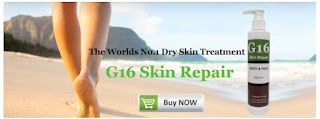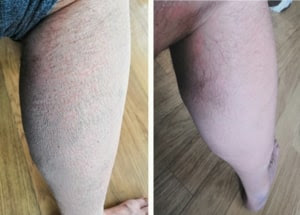Ichthyosis Symptoms and Treatment
Ichthyosis
Ichthyosis (pronounced
"ick-thee-owe-sis")is a category of genetic skin diseases that cause
dry, scaly, thickened skin.
Ichthyosis symptoms include
thick, scaly, dry, and cracked skin. If your child is born with ichthyosis,
their skin may appear normal initially, but it will gradually dry out and
become scaly. Symptoms typically appear by the age of five.
Some children may find the
condition distressing or embarrassing.
It can be very drastic in rare
cases, affecting the entire skin surface or causing blisters. Repeated
infections, discomfort, and sweating problems are possible in this case.
Inherited ichthyosis is usually
present at birth or develops during childhood. Ichthyosis is a genetic disease
that is not infectious and is not caused by infection (it cannot be caught by
others).
If you are concerned about your
child's skin, see a doctor. The doctor will be concerned about your child's
skin and may refer you to a pediatrician or dermatologist (skin
specialist). A skin biopsy (a small sample of skin taken with an anesthetic)
and a genetic test (blood or saliva) may be needed for a diagnosis.
There are different sorts of
medicines employed for ichthyosis treatment.
Keratolytics help to loosen the
hierarchies on the skin and promote them to come off. They are found in
skincare products that also moisturize the skin. Sadly, they can also be
annoying, causing redness, stinging, itching, or discomfort. The power of the
cream can be changed - if any of these symptoms appear.
Salicylic acid and lactic acid 1%
creams
ammonium lactate (e.g., Lanate)
urea creams, hydroxy acid creams
(e.g., NeoStrata) (e.g., Urederm, Eulactol, Calmurid).
In severe cases of ichthyosis, a
retinoid (e.g., Neotigason) can be beneficial in removing the scale, skin
irritation, and itch.
If your child has ichthyosis, you
may need to spend time caring for their skin every day.
●
Creams assist in enhancing the
condition of dryness by replacing lost moisture and retaining it in the skin.
They must be used regularly, especially after showering or bathing.
Moisturizers such as QV cream, Atoderm crème, Kenkay cream, Dermeze, sorbolene,
and glycerine seem to be examples.
●
Instead of soap, which can
further dry out the skin, use a soap replacement, such as oils and cleans
(e.g., Hamilton's bath oil, QV bath oil, Dermaveen shower, etc.), and bath oil,
Hamilton wash, QV wash).
●
If your child's baths contain
bleach (along with the bath oil or wash), this can assist in decreasing
microbes on the skin and prevent further infections. For more information, see
our fact sheet Skin infections - bleach baths.
●
Shampoos usually contain
salicylic acid or tar can help to reduce scaling and relieve itching on the
scalp (e.g., NeoCeutical shampoo and Ducray Kertyol shampoo). Brush the hair
after washing to remove scales from the scalp.
Follow-Up
Consult your doctor if your
child's skin suddenly becomes painful, cracked, oozing/weeping/crusting. Your
doctor may specify antibiotics to Ichtyosis cure any skin disease.
Talk to your doctor if you have concerns about your child's treatment. If your child is on oral antibiotics, remember to have periodic blood tests done.
Essential Points to Remember
An ichthyosis is a group of genetic
skin diseases recognized by dry, scaly, thickened skin.
It is usually present at birth or
develops later in life.
Most children with ichthyosis
have a mild form of the disease that has little impact on their overall health
and well-being. Ichthyosis can be severe in some children, affecting the entire
skin surface or causing blisters.
Treatment may include medications
as well as proper skin care.
If your child is prescribed
retinoid medication, they must undergo blood tests and check-ups regularly.
Ichthyosis (pronounced
"ick-thee-owe-sis")is a category of genetic skin diseases that cause
dry, scaly, thickened skin.
Although there is no known cure for Ichthyosis, there are treatments that can help to improve the skin's condition.
Ichthyosis Signs and Symptoms
Ichthyosis symptoms include
thick, scaly, dry, and cracked skin. If your child is born with ichthyosis,
their skin may appear normal initially, but it will gradually dry out and
become scaly. Symptoms typically appear by the age of five.
Ichthyosis can affect any part of the body, including the face and scalp; however, the bends in the arms and legs are usually unaffected. The palms and soles of the feet have thick skin.
Most children with ichthyosis have a mild form of the disease that has little impact on their overall health and well-being.
Some children may find the
condition distressing or embarrassing.
It can be very drastic in rare
cases, affecting the entire skin surface or causing blisters. Repeated
infections, discomfort, and sweating problems are possible in this case.
What is the Source of Ichthyosis?
Inherited ichthyosis is usually
present at birth or develops during childhood. Ichthyosis is a genetic disease
that is not infectious and is not caused by infection (it cannot be caught by
others).
Acquired ichthyosis is more common in adults and can be provoked; by various conditions or medications.
When to see a Doctor
If you are concerned about your child's skin, see a doctor. The doctor will be concerned about your child's skin and may refer you to see a pediatrician or pediatric dermatologist (skin specialist). A skin biopsy (a small sample of skin taken with an anesthetic) and a genetic test (blood or saliva) may be needed for a diagnosis.If the skin on your child's feet is causing problems such as thickened skin, pain, and cracking, your child may require further management and treatment from a podiatrist.
Treatment for Ichthyosis
There are different sorts of
medicines employed for ichthyosis treatment.
Keratolytics
Keratolytics help to loosen the
hierarchies on the skin and promote them to come off. They are found in
skincare products that also moisturize the skin. Sadly, they can also be
annoying, causing redness, stinging, itching, or discomfort. The power of the
cream can be changed - if any of these symptoms appear.
Keratolytic good examples of include:
Salicylic acid and lactic acid 1% creams
ammonium lactate (e.g., Lanate)
urea creams, hydroxy acid creams
(e.g., NeoStrata) (e.g., Urederm, Eulactol, Calmurid).
Retinoids
In severe cases of ichthyosis, a
retinoid (e.g., Neotigason) can be beneficial in removing the scale, skin
irritation, and itch.
High vitamin A doses can cause dry eyes, lips, and nose. Nasal bleeds, headaches, nausea, and high blood cholesterol are some of the additional side effects. High doses of vitamin A can lead to birthmarks if taken during pregnancy.
Dermatologists can only prescribe retinoids, which must be closely monitored - with regular health checks and blood tests.
At-Home Care
If your child has ichthyosis, you
may need to spend time caring for their skin every day.
●
Creams assist in enhancing the
condition of dryness by replacing lost moisture and retaining it in the skin.
They must be used regularly, especially after showering or bathing.
Moisturizers such as QV cream, Atoderm crème, Kenkay cream, Dermeze, sorbolene,
and glycerine seem to be examples.
●
Instead of soap, which can
further dry out the skin, use a soap replacement, such as oils and cleans
(e.g., Hamilton's bath oil, QV bath oil, Dermaveen shower, etc.), and bath oil,
Hamilton wash, QV wash).
●
If your child's baths contain
bleach (along with the bath oil or wash), this can assist in decreasing
microbes on the skin and prevent further infections. For more information, see
our fact sheet Skin infections - bleach baths.
●
Shampoos usually contain
salicylic acid or tar can help to reduce scaling and relieve itching on the
scalp (e.g., NeoCeutical shampoo and Ducray Kertyol shampoo). Brush the hair
after washing to remove scales from the scalp.
Children and their families can be distressed by ichthyosis. Children with the disorder may experience low self-esteem, teasing, or bullying. Meeting other young people in the same situation can be beneficial (for more information, see the section below).
Follow-Up
Consult your doctor if your
child's skin suddenly becomes painful, cracked, oozing/weeping/crusting. Your
doctor may specify antibiotics to Ichtyosis
cure any skin disease.
Talk to your doctor if you have concerns about your child's treatment. If your child is on oral antibiotics, remember to have periodic blood tests done.
Essential Points to Remember
An ichthyosis is a group of genetic
skin diseases recognized by dry, scaly, thickened skin.
It is usually present at birth or
develops later in life.
Most children with ichthyosis
have a mild form of the disease that has little impact on their overall health
and well-being. Ichthyosis can be severe in some children, affecting the entire
skin surface or causing blisters.
Treatment may include medications
as well as proper skin care.
If your child is prescribed
retinoid medication, they must undergo blood tests and check-ups regularly.




Comments
Post a Comment